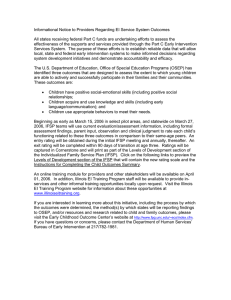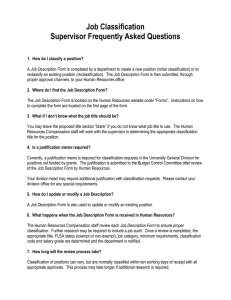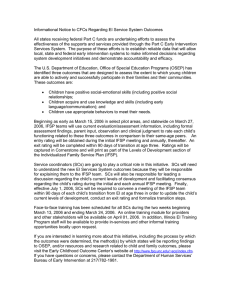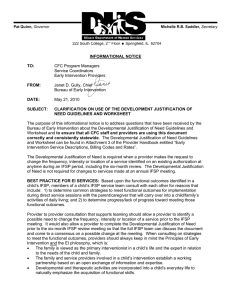Early Intervention Providers Janet D. Gully, Chief Bureau of Early Intervention
advertisement
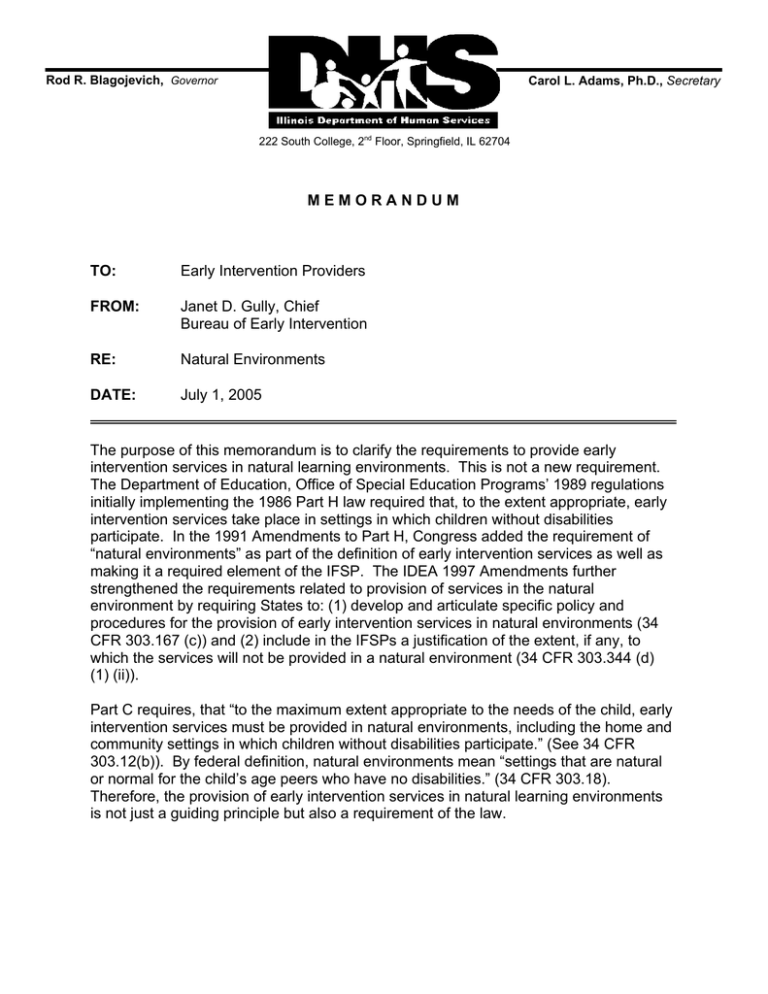
Rod R. Blagojevich, Governor Carol L. Adams, Ph.D., Secretary 222 South College, 2nd Floor, Springfield, IL 62704 MEMORANDUM TO: Early Intervention Providers FROM: Janet D. Gully, Chief Bureau of Early Intervention RE: Natural Environments DATE: July 1, 2005 The purpose of this memorandum is to clarify the requirements to provide early intervention services in natural learning environments. This is not a new requirement. The Department of Education, Office of Special Education Programs’ 1989 regulations initially implementing the 1986 Part H law required that, to the extent appropriate, early intervention services take place in settings in which children without disabilities participate. In the 1991 Amendments to Part H, Congress added the requirement of “natural environments” as part of the definition of early intervention services as well as making it a required element of the IFSP. The IDEA 1997 Amendments further strengthened the requirements related to provision of services in the natural environment by requiring States to: (1) develop and articulate specific policy and procedures for the provision of early intervention services in natural environments (34 CFR 303.167 (c)) and (2) include in the IFSPs a justification of the extent, if any, to which the services will not be provided in a natural environment (34 CFR 303.344 (d) (1) (ii)). Part C requires, that “to the maximum extent appropriate to the needs of the child, early intervention services must be provided in natural environments, including the home and community settings in which children without disabilities participate.” (See 34 CFR 303.12(b)). By federal definition, natural environments mean “settings that are natural or normal for the child’s age peers who have no disabilities.” (34 CFR 303.18). Therefore, the provision of early intervention services in natural learning environments is not just a guiding principle but also a requirement of the law. Early Intervention Providers Page 2 July 1, 2005 The Individuals with Disabilities Education Improvement Act of 2004 amended section 635(a)(16)(B) to read: (a) A statewide system described in section 633 shall include, at a minimum, the following components: (16) Policies and procedures to ensure that, consistent with section 636 (d) (5) (B) the provision of early intervention services for any infant or toddler with a disability occurs in a setting other than a natural environment that is most appropriate, as determined by the parent and the individualized family service plan team, only when early intervention cannot be achieved satisfactorily for the infant or toddler in a natural environment. (Italicized words denote amendments to the IDEA) The Conference Report states: The legislation amends current law to recognize that there may be instances when a child’s individualized family service plan cannot be implemented satisfactorily in the natural environment. The Conferees intend that in these instances, the child’s parents and the other members of the individualized family service plan team will together make this determination and then identify the most appropriate setting in which early intervention services can be provided. H.R. Conf. Rep. No 108-779, at 238 OSEP has had a longstanding interpretation of the IDEA that early intervention services must be provided in a natural environment, unless a written justification exists for providing these services in other settings. Because Part C services must be tailored to the unique needs of the individual child and family (see 34 CFR 303.344 (d)), no one setting is appropriate for all infants and toddlers. OSEP expects Illinois to continue its general supervision responsibilities under 34 CFR 303.501 in the identification and correction of noncompliance with all of the Part C requirements, including the natural environment requirements under current regulations. The outcome page of the IFSP specifically asks whether or not all EI services are provided in natural environments. If the answer is no, then effective July 1, 2005 all Service Coordinators will begin using the attached general guidance and worksheet in IFSP meetings when developing the justification for services outside of a natural learning environment. Justification should incorporate a plan to transition interventions into natural settings. Natural Environments Worksheet Child’s Name: Date: Natural Environments Justification Outcome # : Service (s): Environment in which service(s) will be provided: Explain why the IFSP team determined that it was not appropriate to provide this service in a Natural Environment: Outcome # : Service (s): Environment in which service(s) will be provided: Explain why the IFSP team determined that it was not appropriate to provide this service in a Natural Environment: Outcome # : Service (s): Environment in which service(s) will be provided: Explain why the IFSP team determined that it was not appropriate to provide this service in a Natural Environment: Natural Environments Justification Worksheet Review area A. Adequate information and evidence is provided to support the rationale that a child’s needs and outcomes cannot be achieved in natural settings. 1 (unacceptable) The IFSP identifies one or more services that are not in a natural environment for the child and family AND There is no justification or the justification is not based on the needs of the child but appears to be for: administrative convenience, and/or fiscal reasons, and/or 3 (acceptable) The child is receiving most services in natural environments AND When a service is provided in a setting that is not a natural environment, a justification is included in the IFSP that is based on the needs of the child, justifying that the setting is necessary to achieve the outcome. 5 (best practice) All services are provided in natural environments. OR The child is receiving most services in natural environments AND When a service is provided in a setting that is not a natural environment, a justification is included in the IFSP that is based on the needs of the child, justifying that the setting is necessary to achieve the outcome. personnel limitations, and/or parent/therapist preferences. AND For each service justified there is a plan to transition interventions into natural settings.
